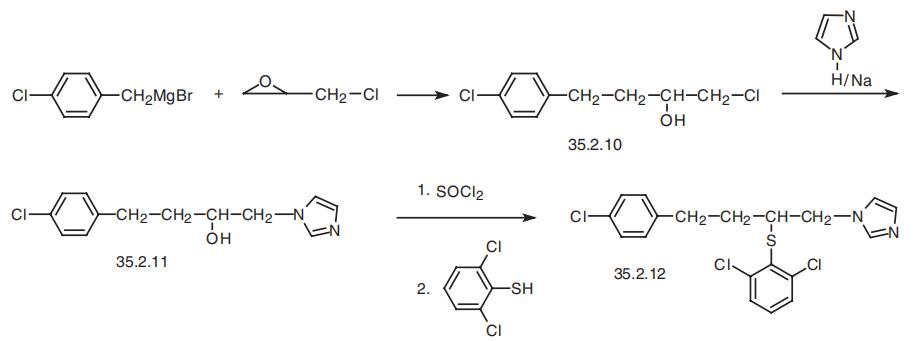| Identification | More | [Name]
Butoconazole | [CAS]
64872-76-0 | [Synonyms]
BUTOCONAZOLE
Butooonazole
BUTONAZOLE
1-[4-(4-Chlorophenyl)-2-(2,6-dichlorophenyl)sulfanyl-butyl]imidazole
(±)-1-[4-(4-Chlorophenyl)-2-[(2�,6-dichlorophenyl)thio]butyl]-1H-imidazole
1-[2-[(2,6-Dichlorophenyl)thio]-4-(4-chlorophenyl)butyl]-1H-imidazole | [Molecular Formula]
C19H17Cl3N2S | [MDL Number]
MFCD00865616 | [Molecular Weight]
411.78 | [MOL File]
64872-76-0.mol |
| Hazard Information | Back Directory | [Description]
Butoconazole is an imidazole that is pharmacologically quite comparable to clotrimazole. It is a vaginal antifungal agent that increases cell membrane permeability in susceptible fungi. It is indicated for local treatment of vulvovaginal candidiasis (moniliasis). | [Uses]
antineoplastic, pyrimidine antimetabolite | [Uses]
Butoconazole is a fungostatic drug, and it is formally classified as an imidazole, but only
because of the presence of an imidazole ring in the structure. It is believed that butocona�zole, like miconazole, econazole, and other “pure” representatives of the imidazole class,
also inhibits the biosynthesis of estrosterin in the cytoplasmatic membrane of fungi; how�ever, it is very possible that this is not the only mechanism of its action. It is effective for
vaginal infections caused by various types of candida. It is also used only externally and
vaginally. Synonyms of this drug are femstat, listomin, and others. | [Definition]
ChEBI: A member of the class of imidazoles that is 1H-imidazole in which the hydrogen attached to the nitrogen is substituted by a 4-(4-chlorophenyl)-2-[(2,6-dichlorophenyl)sulfanyl]butyl group. An antifungal agent, it is used as its nitrate sa
t in gynaecology for treatment of vulvovaginal infections caused by Candida species, particularly Candida albicans. | [Indications]
Butoconazole is generally indicated for therapy of vulvovaginal mycoses
caused by Candida species and Candida (Torulopsis) glabrata. | [Brand name]
Femstat (Roche);Femstat 3 (Bayer); Gynazole-1 (KV Pharmaceutical). | [Antimicrobial activity]
Broad-spectrum
imidazole antimycotic with in vitro and in vivo
activitiy against pathogenic yeasts, dermatophytes, moulds, and dimorphic fungi. | [Side effects]
Local irritations such as itching and burning sensations and allergic reactions
may occur in rare cases and are mainly due to
the galenic formulation. | [Synthesis]
Butoconazole, 1-[4-(4-chlorophenyl)-2-[(2,6-dichlorophenyl)thio]butyl]-
1H-imidazole (35.2.12), is synthesized from 4-chlorobenzylmagnesium bromide, which is
reacted with epichloridrine to make 4-(4�-chlorophenyl)-1-chlorobutan-2-ol (35.2.10),
which is reacted with imidazole in the presence of sodium to make 4-(4�-chlorophenyl)-
1-(1H-imidazolyl)butanol-2 (35.2.11). The hydroxyl group in the last is replaced with a
chlorine atom upon reaction with thionyl chloride, which is then by the reaction with 2,6-
dichlorothiophenol butoconazole, is obtained.
| [Enzyme inhibitor]
This fungicide (FW = 411.78 g/mol; CAS 64872-77-1), also known as
Femstat?, Femstat-3?, Gynazole-1?, and systematically as 1-[4- (4-
chlorophenyl) -2-[ (2,6-dichlorophenyl) -sulfanyl]butyl]-1H-imidazole (* =
chiral center), is believed to inhibit steroid synthesis, targeting the
conversion of lanosterol to ergosterol and modifying membrane
composition/function. At 80 μM, butoconazole was strictly fungistatic
against early stationary-phase Candida albicans cells. During early log-
phase growth, butoconazole were highly lethal at 20 μM. In 1995,
butoconazole was approved for treatment of vaginal yeast infections. | [storage]
Store at -20°C |
|
|